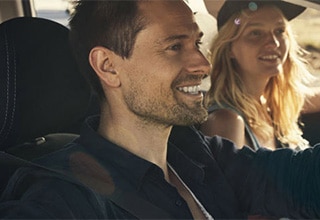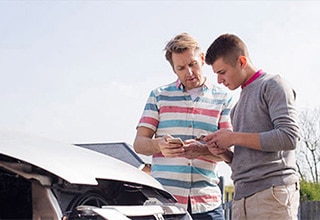- text
-
Cover and benefits are subject to eligibility criteria and terms and conditions, including the limits and exclusions of the insurance policy. Any advice provided is general only and may not be right for you. Before you purchase this product you should carefully read the Car Insurance Product Disclosure Statement and consider the Target Market Determination to decide if it is right for you.
How safe is your car?
How safe is your car? It’s no surprise that we spend a lot of our time on the road – our family, kids or partners buckled in beside us. With driving being one of riskiest activities Australians do every day, safety should be a priority for everyone. Sadly, it isn’t always.
Additionally, there are many more crashes that result in serious injuries. It is unfortunate then, that despite the advancement of automobile technology, social awareness about road safety and stricter regulations, car accidents remain among the biggest threat to lives in Australia.
One of the main causes of collisions is human error, through distraction or fatigue. Being a cautious driver can greatly minimise the risk of an accident, but there are many factors aside from driving ability that affect the risk. Here we look at some of the considerations when deciding whether your car is safe and how you can go about creating a safer driving experience for you and your family.
A safer car, a safer journey.
Safety on the road can’t be guaranteed, but a safer car can greatly reduce the risk of a crash resulting in serious injury. The type of car you drive impacts the ability to avoid or survive a crash. So how do you know your car is safe? Vehicle safety ratings offer a good indicator of vehicle safety in the instance of a crash.
When shopping for a car, there are two rating programs that can provide you with the information you need to make a decision about the safest cars to buy. The Australian New Car Assessment Program (ANCAP) perform crash tests which provide an indication of a vehicle’s protective capacity, and the Used Car Safety Ratings (UCSR) provide ratings that are based on real crashes and illustrate the car’s safety performance. We recommend looking at both these rating programs to have a better overall idea about a car’s safety.
So what actually makes a car safe?
In short, a safe car offers solid protection for you, your passengers and other road users like cyclists and pedestrians. Safe cars can minimise serious injury to others when involved in a crash, thus large SUVs are generally not considered the safest vehicles on the road due to the likelihood of causing serious injuries to others. Ultimately, a safe car will also have the structural capability to endure severe impact and the ability to withstand the force exerted in a crash, drawing the force away from the occupants. Newer vehicles (those manufactured after 2005) are generally considered to be safer during a crash due to their array of safety features and structural durability.
Safety technologies are constantly evolving to take into account the latest crash data. Aside from seat belts which were introduced as a legal requirement in the 1970s, here are some popular built-in features in new cars:
Standard safety features.
These are safety features that are standard in many new vehicles within Australia:
Emergency brakes and active braking systems (electronic stability control) which assists the driver in critical moments
Front and side airbags
Head restraints to minimise head injuries and whiplash prevention
Anti-lock brakes
Traction control systems – prevent loss of traction when the driver accelerates these are more common in areas of dirt roads or areas that experience ice and snow
Back up warning systems
Extras.
For extra precaution, these built-in features are included in some new vehicles. These are likely to become standard:
Rear-view camera – enables the driver to see obstructions that are immediately behind the vehicle
Dash cam to capture critical information for insurance or legal purposes
Lane departure warning systems – warns the driver when they’ve moved out of their lane
Collision Avoidance Systems – alerts the driver of an impending collision with a pedestrian. It will also automatically apply the brakes to avoid or minimise impact
Automatic Crash Notification – in the event of a crash this technology notifies emergency services of the crash and location
Parking sensors
Inflatable seat belts
Adaptive headlights – illuminating areas where the vehicle is headed rather than where it is pointed
Don’t forget about routine maintenance.
Even if you’re aware about safe cars that doesn’t mean you can run out and buy one straight away.
Buying an ultra-safe car is not an option for everyone, but there are other simple and cost effective ways to ensure your safety on the road. Something as simple as routine car maintenance may seem obvious, but many people fail to regularly take their car to the mechanic for regular check-ups and service. Neglecting your car for months at a time leaves it prone to engine wear, potentially resulting in an accident, and depending on your insurance policy, an accident involving a faulty car may not be covered! This is why it is crucial to be on top of your car maintenance.
If you are a regular driver it can be costly, not to mention inconvenient to get your car checked out every few months. However, getting a professional mechanic to have a look under the hood can save you a lot of anguish and money in the long term. A routine service will usually consist of checking water levels, oil check, the battery and tyres. You can also request your mechanic to look at specific parts and make recommendations, and ensure you tell your mechanic of any concerns you may have.
Creating a safe driving experience relies on a number of factors, including your vehicle’s structural integrity and built-in safety features, cautious driving and regular service to ensure your car’s in top shape. You’ll never be able to eliminate risk entirely, but taking actions to minimise risk can give you peace of mind and more control to protect yourself and your loved ones.




